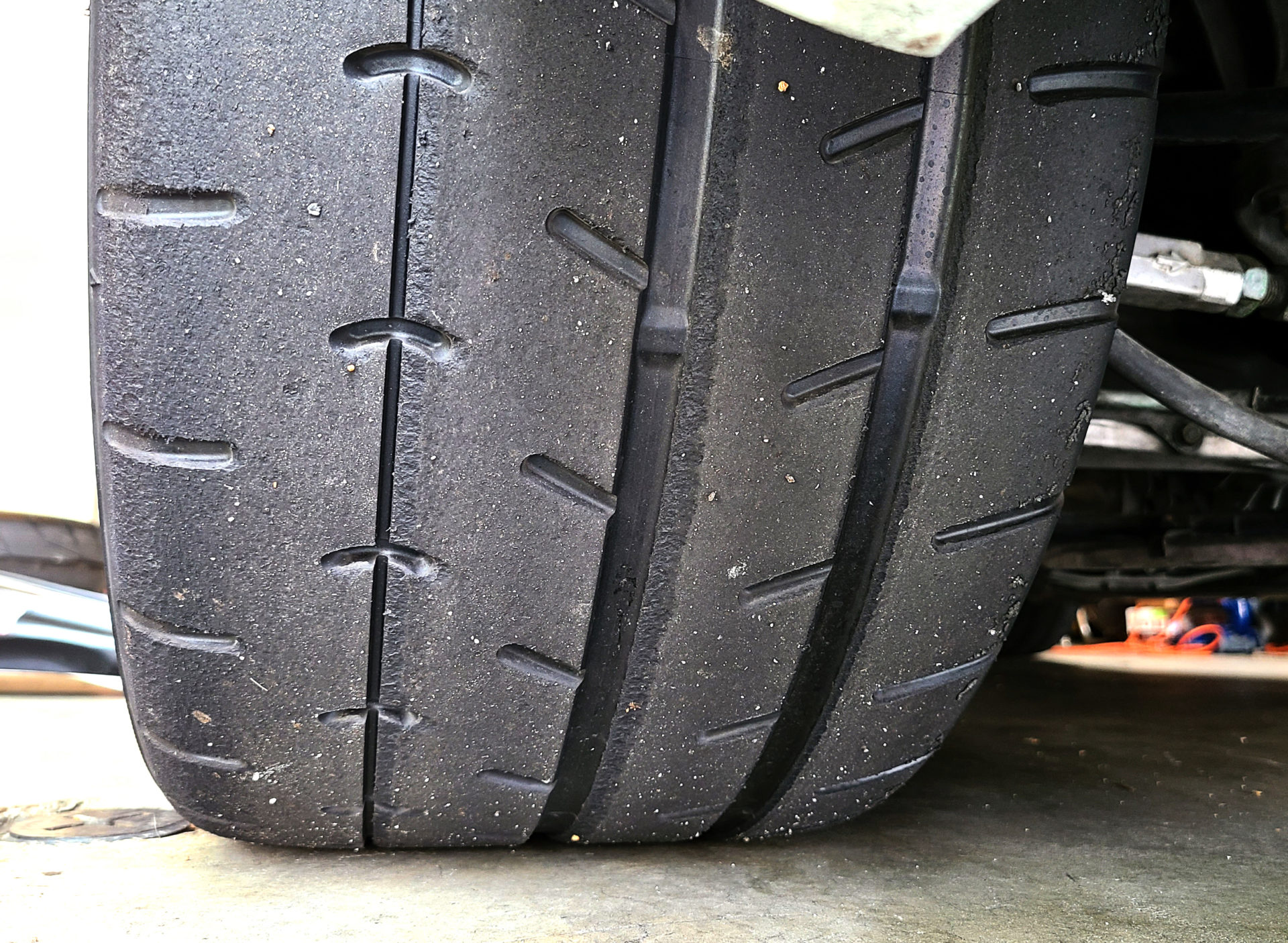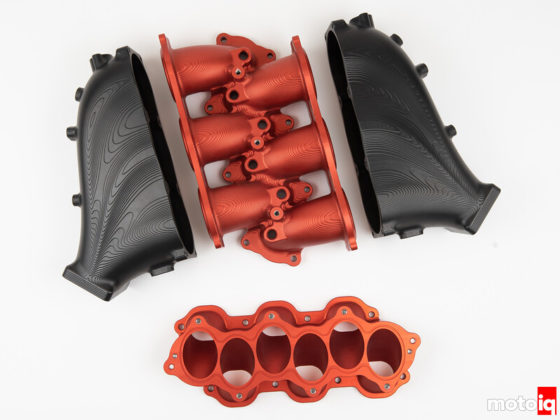When it comes to performance on track, tires are one of the most important factors of a car. We install what is arguably the fastest 200-treadwear “Street” tire on the market, the Yokohama ADVAN A052. We also change the spring rates on our KW coilovers with a set of Swift Springs to improve the balance of our NSX. We then take this new setup to Buttonwillow to see how it performs and if we are able to go faster than our previous lap times.
Regular readers already understand that treadwear ratings are all but pointless. But if you missed that, you can read up on why in the article How to PROPERLY select and size TIRES for PERFORMANCE. Despite this reality, the 200-treadwear tire rating continues to be the hotly contested battleground for tire manufacturers due to the number of competitions, sanctioning bodies, and events that drive a significant demand for tires with this rating.
 Debuting in 2017, the Yokohama ADVAN A052 still reigns as one of the, if not the fastest tire in the 200-treadwear category at the time of this writing in early 2022. If you look up the results from any Time Attack event, track competition, autocross, One Lap of America, or Optima Search for the Ultimate Street Car event, the A052 usually populates most if not the fastest time of the street tire class.
Debuting in 2017, the Yokohama ADVAN A052 still reigns as one of the, if not the fastest tire in the 200-treadwear category at the time of this writing in early 2022. If you look up the results from any Time Attack event, track competition, autocross, One Lap of America, or Optima Search for the Ultimate Street Car event, the A052 usually populates most if not the fastest time of the street tire class.
Yokohama markets the A052 as faster than their A048 “R-compound” tire and even the 60-treadwear Pirelli P-Zero Trofeo R! This just goes to show how insane the tire wars for ‘street’ class tires have become, as we discussed in a recent article about “street” and “R-compound” tires.
 The outer half of the A052 features a wide shoulder and high-stability compound rib that delivers powerful cornering grip. The thin ‘micro-groove’ further helps to enhance heat dissipation with a lot of rubber on the outer shoulder to handle heavy cornering loads. Yokohama has taken their motorsports technology and has infused it into the compounding of the A052.
The outer half of the A052 features a wide shoulder and high-stability compound rib that delivers powerful cornering grip. The thin ‘micro-groove’ further helps to enhance heat dissipation with a lot of rubber on the outer shoulder to handle heavy cornering loads. Yokohama has taken their motorsports technology and has infused it into the compounding of the A052.
The inner half of the A052 features two wide grooves for straight-line stability and superior wet traction. The A052 actually does quite well in the wet and with some standing water.
 Our Project NSX has been running around the street for a while on a set of 18×8.5 +51 front and 19×10 +35 rear Advan Racing RS-II wheels and 235/40-18 front, 275/35-19 rear Nitto NT05 tires. We will review this setup in a future article but we are going back to the tried and true, 17×8+38 front 18×9.5+40 rear Volk CE28 track wheels for this track tire test.
Our Project NSX has been running around the street for a while on a set of 18×8.5 +51 front and 19×10 +35 rear Advan Racing RS-II wheels and 235/40-18 front, 275/35-19 rear Nitto NT05 tires. We will review this setup in a future article but we are going back to the tried and true, 17×8+38 front 18×9.5+40 rear Volk CE28 track wheels for this track tire test.
 Our stack of brand-new Yokohama ADVAN A052 tires arrived and we were excited to put them on and test them out for ourselves. Over the last 12-15 years, the standard track tire package for the NSX has been 235/40-17 front, and 265 (or 275)/35-18 rear.
Our stack of brand-new Yokohama ADVAN A052 tires arrived and we were excited to put them on and test them out for ourselves. Over the last 12-15 years, the standard track tire package for the NSX has been 235/40-17 front, and 265 (or 275)/35-18 rear.




18 comments
That NSX looks fantastic. Why did you go back to the restrictive stock intake manifold and muffler?
A052’s will be my top choice for when go for new tires for my track NC, thanks to your review.
The car looks so right with 17s and 18s vs the larger wheel set. You mention the roll center debacle, but I can’t imagine there’s not correction kits made for the NSX. Have you looked into them?
Like James asked above, why go back to stock exhaust setup? Was the previous setup just too loud?
I’ll be track testing 17/18 vs 18/19 soon.
There are not any roll center correction options out there. Which is why I’ll be developing a billet upright to fix this in addition to the dry sump I designed that retains air conditioning.
The stock muffler was to make the car tolerable until the turbo goes on since the previous exhaust was pretty much straight-piped. The stock manifold was due to the gutted and ported one being modified for a drive by wire throttle which will go on soon.
How disruptive to the drivability of the car would it be to simply make both the front and rear rims sizes 18″? I know the NSX has always been designed with staggered sizes and widths of tires. Would it even be possible to standardize them?
As long as the outer diameters are within the tolerance of the ABS, 18/18 is fine and has been done a lot.
is the vid on page 6 working for everyone else? I get an error (Playback ID: zVTOmS3S9fZHDntm) when I click on it…
Is it working now?
yes, thanks!
Can you explain/educate on your driving style a little please? Going into turn 1 you say “a little bit of entry neutrality” and from what I can observe you did that by turning in sharply and then quickly reducing steering angle. Is to counter the understeer you would have gotten if you turned in more smoothly? And what were you doing with you feet when you did the sharp turn in?
Thanks
started watching your Senna vid, you said the same thing about entry neutrality for turn 1 but didn’t do the sharp turn in then dial back. Can you explain what you mean by “entry neutrality” too? I mean the words are kinda self explanatory, but I’m hoping I can learn something I didn’t think of…
Hi Bob. “neutrality” is when there is little to no steering input as the car is cornering, before the point where the car oversteers and requires counter-steer (steering in the opposite direction of the turn).
To answer your question about what I’m doing with my feet: Half of steering a car through a corner is done with the steering wheel. The other half of steering a car is with your feet – weight transfer from the application of throttle and brake. The NSX has a slower steering rack and the suspension geometry causes the car to turn more as the car is trail-braking. This causes excess rotation, which is why the car rotates and requires less steering after turn-in (“neutrality”). The Senna on the other hand, uses electronics to apply more braking force to the inside rear tire to help turn the car. This sophisticated system, combined with a quicker steering ratio, does not need as an aggressive steering input for turn-in. But as the system works, the car rotates more than the steering input and also gets ‘neutral’, requiring very little steering INTO the corner. However on exit, when the car understeers, you’ll see more steering input.
thanks for going into detail!
love the explanation
Why not get longer springs and ditch the tender springs while you were replacing them?
Longer springs will lower the spring perch height and will interfere with clearance to the tire.
The rear corner weights of the car are ~900lbs. A ~450lb spring will compress 2″ at ride height. Since there is more than 2″ of droop travel in these dampers, longer springs will still become loose and flop around at full droop travel, which is what helper springs prevent by keeping load on the springs at all times. In short, longer springs won’t solve anything and will cause more problems.
Not sure why it’s so hard to weigh stuff before you change it. When you spend money on a part, it’s kinda nice to know that you are getting some kind of improvement.
Call me an engineer, but I always weigh components, and usually break out the calipers to get specs. It’s actually really fun to geek out on this stuff.
Having said that, I really appreciate the write up.
If you read Part 4 where we cover the CE28’s, they are 17×8” +38 front and 18×9.5” +40 rear CE28s to weigh in at 15lbs and 17lbs respectively.
A052 tires in 215/40-17 front and 265/35-18 rear come in at 19 & 24lbs respectively.
Hey Billy, thanks for this! Question. How much front camber were you running